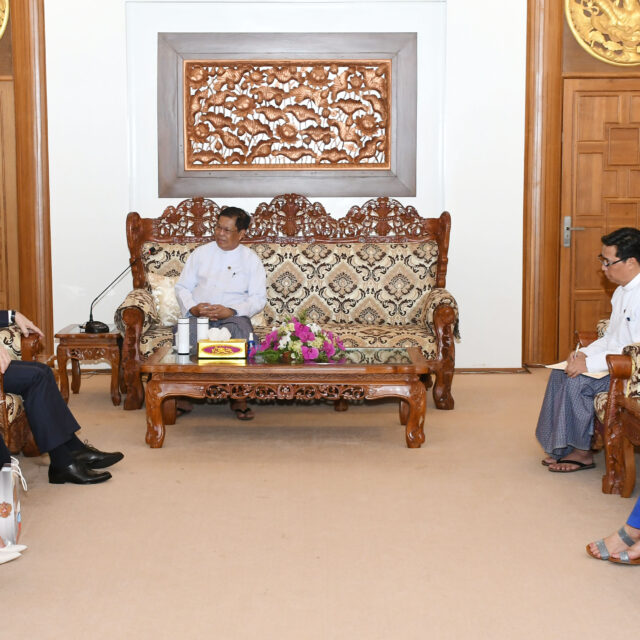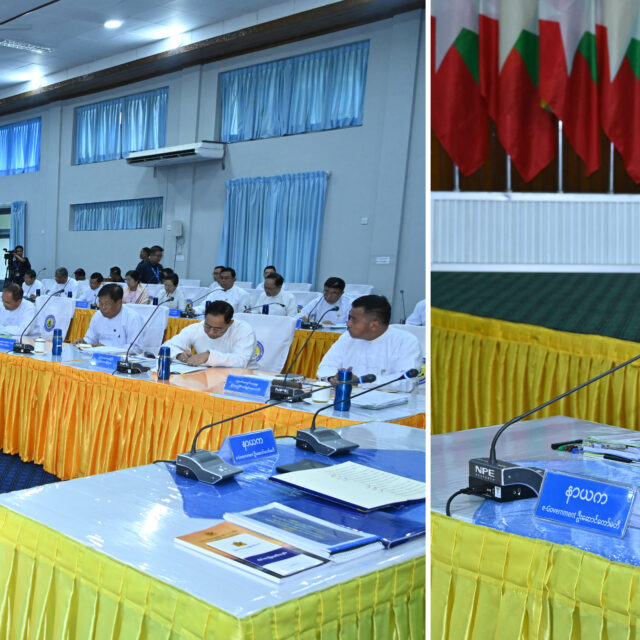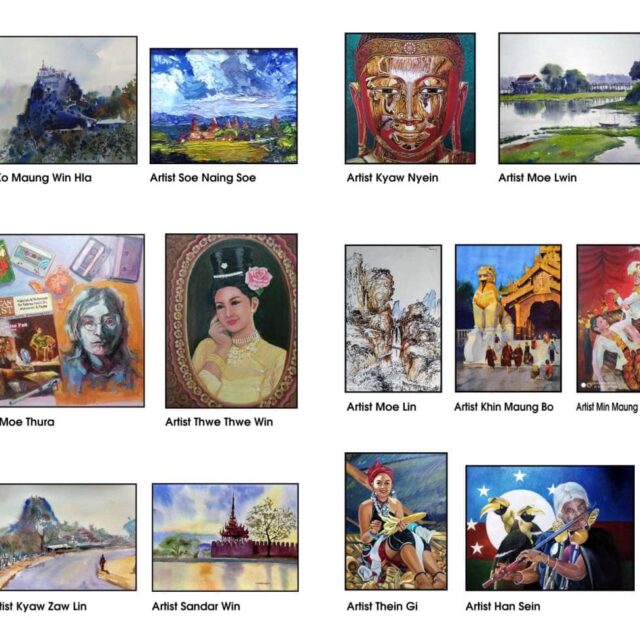EPISODE: 32
Previously, my articles were author-oriented. However, due to some authors contributing to multiple subjects, I’ve had to transition certain articles to be subject-oriented. According to the index of Records of GSI by La Touche, Dr Fritz Noetling contributed 15 reports covering various subjects to Myanmar Geology, including “Notes on the geology of Wuntho in Upper Burma” in 1894. The Wuntho District is renowned for its gold deposits, with the Kyaukpazat gold mine, the first of its kind in Myanmar, situated in the Wuntho-Bamauk region. I am delighted to provide insight into the Wuntho-Bamauk gold field, drawing from my experience in gold exploration and mining with both foreign and local companies between 2005 and 2014.
The Geology of Wuntho in Upper Burma
Due to space limitations, I’ll summarize the key points of GSI palaeontologist Fritz Noetling’s 1894 report, “The Geology of Wuntho in Upper Burma.” as follows: –
Geographical features
The area described in the following pages comprises part of the Wuntho sub-division of the Katha district in Upper Burma. It extends, roughly speaking, between Htygaing on the Irrawaddy and the Mu Valley; in its eastern part only, low hills rise from the surrounding plains, but in its western part, the large massive of the Maingthong hills form a tract of approximately 75 miles in length.
The Maingthong hills, which I partly examined, begin near Lat 23˚ 45’ and Long 90˚ 20’, near the junction of the Daungyu Choung with the Mu River. From this point, the hills extend in a nearly northerly direction, the tract widening out gradually till it reaches its greatest breadth of 30 to 35 miles near Lat. 24˚ 5’.
It may be said to be limited by the broad valleys of Mu and its tributary, the Nam-Maw, in the west, but its eastern boundary is less sharply defined. In the southern part, the broad Wuntho valley forms the boundary, but further, towards the north, the low hills to the east come quite close up to the central massive, forming for some distance a low watershed between the Meza and Mu River. North of these low hills, the eastern boundary is again well-defined, being formed by the broad valley of the Meza River.
The highest point in this hilly tract is Maingthong Hill (5,510 feet), the southwestern spurs of which have been geologically examined.
The Toung-thon-lon (5,565 feet) at Lat 24˚ 56’ and Long 95˚ 52’may possibly form the northern continuation of the Maingthong tract, but it was not visited.
Geological features
I can only give a rough outline of the geological features of this area, owing to almost unsurmountable difficulties which the dense, nearly impenetrable jungle places in the way of geological research. Here and there, a rock protrudes from under the thick vegetable mould that covers the ground everywhere. But nothing can be seen of the dip and strike of the strata. The trained eye, however, learns very soon about the jungle from the difference in the surface soil and whether a change like the underlying rocks has taken place.
As far as I could ascertain, only eruptive rocks take part in the formation of the Maingthon hill tract, whilst the surrounding low hills to the east, south, and west of the eruptive mass consist of Miocene beds, both of the lower or Chindwin and the upper or Irrawaddy group. Older formations occur only close to the Irrawaddy River, where the low ridge which runs almost due north, near Htigaing, is formed by mica schists, with an easterly dip; some traces of metamorphized carboniferous limestone may be seen on the eastern side of the ridge which forms the watershed between the Meza and Mu River, the crest of which is formed by an extensive serpentine dyke.
Eruptive Rocks
1. Quartz Diorite: The rock which is chiefly developed in the Maingthong hill tract is a crystalline rock which, from its outward appearance, must be placed between granitites and quartz diorites. So far as it is known, the quartz diorite occupies chiefly the central part of the tract; it is well seen on the road from Wuntho to Pinlebu, between the villages of Myelin and Hethat, that this so may be seen on the footpath which leads from Wuntho to Myelin, but the locality where I found it best developed is the Tayaw Choung, a feeder of the Yu River; here enormous may be seen in rounded forms covering the slopes. Occasionally, veins of white quartz may be seen in the diorite, but as far as I know, they are not metalliferous.
2. A close connection with the diorite occurs, and a hard black rock develops either in homogenous masses or is well stratified. This mode of occurrence may be seen in the Nam-Maw ravine, east of Mawteik; after having passed Mawteik where a truly intrusive rock of the trap can be seen, an exceedingly hard dark rock forms the bed of the river, for about half an hour this rock may be traced without any apparent change being noticed, excepting occasional fissures; then the rock disappears beneath the jungle, and when it crops out again, it is apparently of the same type, but now well stratified. The strike is 45˚ N E-S W and the dip is 45˚ W. It is crossed by a system of jointing, running 340˚ N N W – S S E and dipping 62˚ E.
Mr. Holland describes this rock as follows: – A compact bluish-green rock breaking with a semi-conchoidal fracture, studded with minute grains of magnetic pyrites and pyrrhotite, the last-named minerals occurring also in irregular patches. Specific gravity 2.86. Under the microscope, the rock presents the characteristics of a volcanic agglomerate rather than an ordinary lava or dyke rock. Fragments of plagioclase feldspars, hornblende, and augite in all stages of decomposition are mixed with opaque grains of magnetite and pyrites in a microlithic groundmass. It contains a trace of gold, not enough for estimation. He further remarks that only the occurrence in the field can decide exactly the origin of the rock, but from the microscope alone, it seems to be a consolidated volcanic ash.
This hardened volcanic ash may be seen all along the outskirts of the Maingthong hill tract forming the surrounding region particularly; I first noticed it near Padeingon, about 15 miles in a straight line north of Wuntho, and from there I traced it all along the lower hills which form the outskirts via Pinlon, Kyaungon, as far as Wuntho; on the road from Wuntho to Pinlebu between the 7th and 8th mile where there are extensive old gold -diggings, this hardened volcanic ash shows, according to Mr. Holland, the same composition as that from Mawteik which is not less than 28 miles in a straight line distant from that place. Here, the simultaneous occurrence of the stratified and the non-stratified rock exhibits the following characteristics: –
A coarser-grained rock than that from Mawteik, presenting the characteristics of a compact and altered agglomerate. There is considerable development of epidotes at the expense of decomposing felspathic material in large quantities. Undoubtedly, subsequent eruptions produced dykes, which intruded into the surrounding ash masses, and these dykes chiefly attract our attention. They were of two types- one, closely allied in composition to the diorite; the second, chiefly consisting of felspathic quartz, which contains a more or less considerable quantity of auriferous pyrites.
(a) Pyritic Veins (auriferous): Beginning from the north, the following localities are known where these veins occur: – 1. Gwegyi, 2. Toungni near Padeingon, 3. Chouk-paza-doung, close to Padeingon. 4. Theindoo-choung, near Pinlon, 5. Mayutha. All these places are quite close to each other, the distance from Mayutha to Gwegyi being not more than 12 miles in a beeline. So far as it has been observed, the veins do not run in any particular direction, but I may be wrong here. The thickest vein which I have seen is that of Toungni; the ore contained a comparatively small quantity of pyrites; on the assay, it yielded four dwt 15 grs of gold to the tonne. The ore from Chouk-paza-doung, which occurs in a vein of about 9 to 12 inches in thickness, is much richer in pyrites, but it yielded only 1 dwt 7 grs of gold. Typical localities of the second mode of occurrence of the pyrites are- 1. Gotama Hill near Wepone, north of Wuntho, 2. Kyoukpyu, between the VII and VIII miles on the road from Wuntho to Pinlebu, 3. Nam-Maw east of Mawteik, Pinlebu Sub-division.
(b) Galeniferous veins (argentiferous): Besides the pyritic ore, a galeniferous vein of Cerussite occurs on the western side of the Maingthon hill tract under very similar circumstances. The first locality where I found it is called Kaydwin (Kay-lead, dwin-mine), situated in the ravine of the Nam-Maw, east of Mawteik and still further to the east from the place where the pyritic ash had been observed. The thickness varies, but on average, it is not less than 4 feet. The cracks of this vein are filled with Cerussite veins, which form thin layers encrusting the rock. According to Mr Holland, it yielded 69.1 per cent lead and 33 oz. 16 dwt. 4grs. of silver to the ton of lead.
(c) Salt springs: Another remarkable occurrence within the area of volcanic ash on the western side of the Maingthon hill tract is salt springs. Such places are Kyatngat, Kaydwin, Taungmaw, Natdaw, Mangyi, the Nammaw Ravine, and six other places.
The Younger Formations
Maingthon hill tract is surrounded by tertiary strata, which in no way differ from those observed elsewhere in Burma. On the western side, the older tertiaries or Chindwin group may be traced for a long distance; it is followed by the upper tertiaries, the Irrawaddy sandstone that extends to the west as far as the Chindwin. On the eastern side, there are numerous outcrops of coal seams, which, beginning north, run as follows: –
1. Choukpya Chong between Mansigale and Pinmu.
2. Tabawda Chong is a feeder of the Tayaw Chong, about three miles southwest of Mansigale.
3. Milaunggon, east of Pinlebu.
4. Subokom, about 34th mile from Wuntho.
5. Moungaw Stream is near Yuyinbyet village and south of Pinlebu.
6. Wetabin Chong is about one mile west of Engwe village on the Yu River.
Economic value of the minerals
1. General Conditions: As regards accessibility, there can be no doubt that the opening of the railway line to Wuntho has greatly facilitated mining enterprise in those parts of Burma. Without the railway, mining in such a country would be out of the question altogether; the forty-odd miles from Htigaing, the nearest river station, to Wuntho, across the country, which is a swamp for the greater part of the year, would never permit any mining enterprise. To sum up, accessibility in all cases, except the coal and lead mines, is fairly good. Water and fuel were plentiful; the local supply of labour was next to none.
2. Value of the Minerals: The value of the different minerals which are likely to be exploited. These are-
i. Auriferous pyrites: But my opinion is that I do not believe that the occurrence of metallic gold at the outcrop of these lodes will continue to any great depth. Sooner or later, it will disappear and be replaced by undecomposed iron pyrites.
ii. Argentiferous Cerussite: The results of the analysis prove that this is a precious ore, but it remains doubtful whether these ores could be worked profitably under the present conditions of railway communication and costly labour.
iii. Coal: According to the analysis, coal is of good quality, but not mainly from Kabwet or Chindwin.
iv. Salt: I have already stated that these springs are almost always found along the stream beds, and the natives have overcome the difficulty of obtaining a strong brine for evaporation in a most ingenious way.
References:
1. Noetling, Fritz, 1894: Notes on the Geology of Wuntho in Upper Burma, Records of Geological Survey of India, Vol. XXVII.
2. Than Htun 2005: Notes on Kyaukpazat gold mines, Wuntho gold field. Ruby Dragon Mining Co Ltd.














